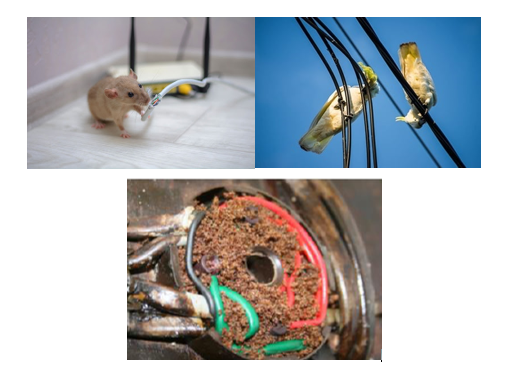One can notice the squirrels jumping about one’s lawn or trying to climb up a tree. They look like happy, little creatures running around going about their business. They are identified by their bushy tails and large eyes. As squirrels belong to the species Rodentia, their front teeth continuously keep on growing throughout their life and to keep them sharp and trimmed. they keep gnawing on things.
Even though they seem harmless, these little creatures can become a headache real quick. Because of their constant chewing, they are more often than not causing damage to somebody’s property or belongings.
Squirrels can invade your houses by creating holes in the insulation and also roof. They gnaw and damage the wooden articles in and around houses. Besides this, usually squirrels are the main culprits for many power outages and network issues that take place. They gnaw the cables or wires to sharpen their teeth. They also chew on the insulation on wires causing outages and fire hazards.
Power outages caused by squirrels are common and widespread around the globe and many a times lead to black outs. Such incidences have led to power grids being shut down across the world.
Some incidences have been quoted below:
Power outage in northern Mecklenburg Co. caused by squirrel, officials say
Power outage Saturday affecting about 10K in northern Meck Co. caused by squirrel
October 23, 2021 By WSOCTV.com News Staff
MECKLENBURG COUNTY, N.C. — Officials said a power outage Saturday morning affecting about 10,000 customers in northern Mecklenburg County was caused by a squirrel.
The outage, which began at 8:30 a.m. Saturday, was last projected to end by 12:30 p.m. the same day, according to EnergyUnited.
Crews found a squirrel in the Northcross Substation, officials said, which caused the outage. It affected about 10,000 customers in the Huntersville and Cornelius areas.
In a post on Facebook, Huntersville Police said traffic signals were not working. Police instructed residents to treat traffic lights that weren’t operating as a four-way stop. Police updated at 11:30 Saturday morning that power had been restored to the area.
EnergyUnited said they are working to backfeed power to the station and then will energize 8 circuits individually.
“Nibbling squirrel causes outage at grocery store”
Early morning grocery shopping was interrupted at Hannaford Sunday when the store lost electricity thanks to a squirrel that apparently was noshing on some wires.
“The power was out for a bit less than two hours on Sunday due to an electrical disruption caused by a squirrel,” said Hannaford spokeswoman Ericka Dodge. “The store reopened at 9:50 a.m. after losing power at 7:30 a.m.”
“Squirrels cause 30% of power outages”
For Owensboro Municipal Utilities, squirrels are public enemy No. 1.
Sonya Dixon, public relations and communications manager at OMU, says 30% of the utility’s power outages since June 1 have been caused by squirrels.
That damage cost OMU $20,000 for repairs.
And squirrels have accounted for six disruptions on OMU’s fibernet service during the same period, Dixon said.
One outage on Aug. 21 cost $20,000 to repair, she said.
Squirrels like to sharpen their teeth on utility lines, Dixon said.
“They are very destructive,” she said. “We have wildlife guards on our equipment, but squirrels are very difficult to keep out. They’re very stubborn and very innovative.”
Sometimes, chewing into a power line will electrocute a squirrel, Dixon said.
But sometimes, they get lucky.
And sometimes, they just cut into a line deep enough to let water in and finish the damage
Any fool proof way to stop their menace has not yet been identified. Trapping using mechanical contraptions and using glue boards are not very effective measures. They are also very easily able to bypass squirrel guards and grease that is used as a method to curb their activities.
This poses the question, what really can be done to address the problem once and for all. Is there at all a solution to this menace?
Well, C Tech Corporation, has the perfect solution to overcome the damage caused by these squirrels. RodrepelTM is an anti-rodent and animal aversive repellent which is extremely low in toxicity and extremely low hazard, environmentally safe solution. It is engineered using a unique set of complex compounds. It follows 6 pronged strategies which are extremely effective on rodents like the squirrel, rat, beaver, gopher, marmot, etc.
RodrepelTM is available in the form of a masterbatch, liquid concentrate, lacquer, wood polish additives and sprays.
The masterbatch can be incorporated in cable sheathing thereby making it rodent resistant. The product in the form of liquid concentrate can be diluted in paints and organic solvents and applied to cables. The lacquer which is a topical application that can be directly applied on the already installed wires and cables, cabinets and transformer boxes. The wood polish additives can be mixed with the wood polish and applied on wooden surfaces.
The liquid concentrate can be sprayed around the areas the showing regular squirrel activities. The lacquer as well as the wood polish additive can be applied onto wooden poles where the squirrels keep climbing.
The Rodrepel™ Rodent Repellent Spray is an easy to use product that can be sprayed on wires and cables, electronic appliances, cabinets, so as to as avoid the rodents from entering them.
RodrepelTM is cost-effective, inert, and thermally stable and does not degrade on exposure to heat and sunlight. It is RoHS, RoHS2, RoHS3, REACH, NEA, EU BPR, APVMA compliant and FIFRA exempted.
It is 100% green, eco-friendly, low in toxicity, non-hazardous, non-carcinogenic and non-mutagenic.
Contact us at technical.marketing@ctechcorporation.com to know more about the use of our repellent products against rodent menace.
Also, visit our websites:
http://www.ctechcorporation.com/
Follow our Facebook pages at:
1] https://www.facebook.com/Combirepel-411710912249274/
2] https://www.facebook.com/Termirepel-104225413091251/
3] https://www.facebook.com/Rodrepel-120734974768048/
Follow us on our Twitter pages at:
1] https://twitter.com/rodrepel

